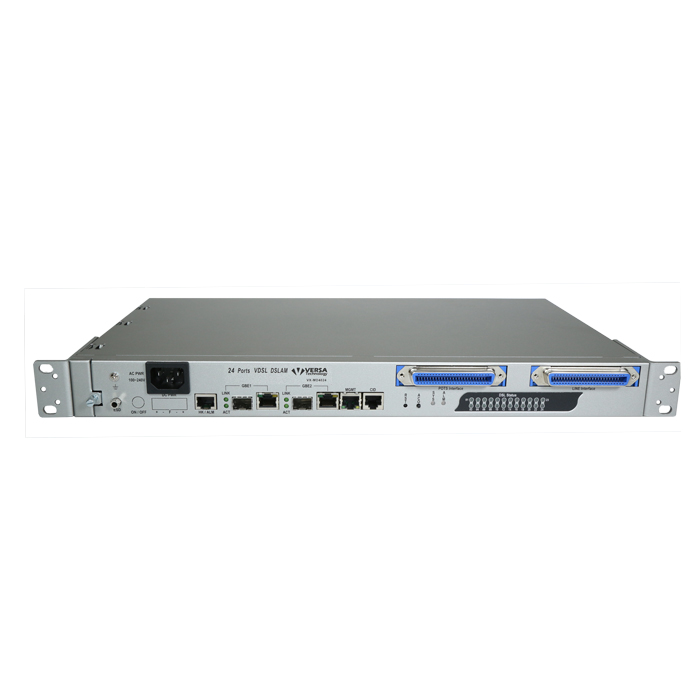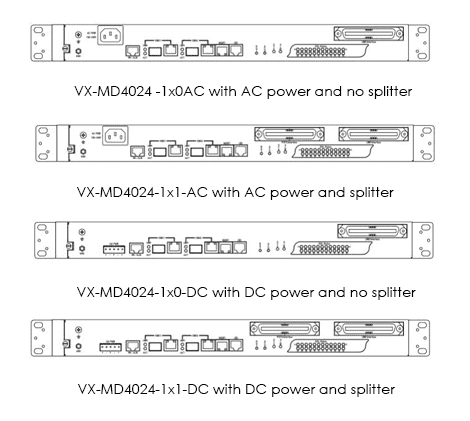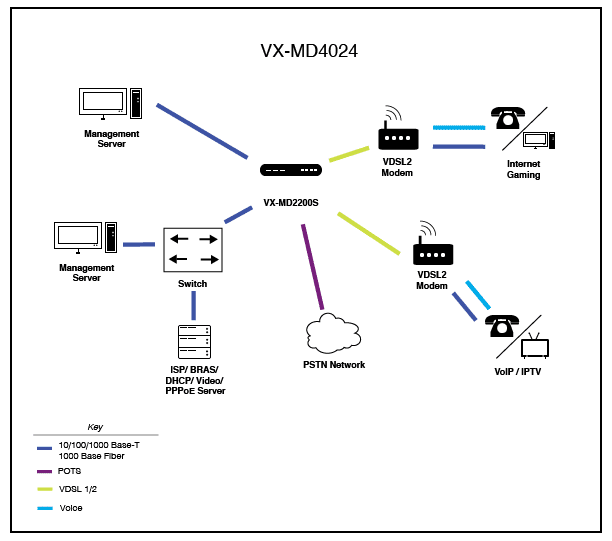Reach out for more Info on this device and its availability. $2,199.00
VX-MD4024 24 Port VDSL2 IP DSLAM
The VX-MD4024 is a rack-mountable VDSL2 IP DSLAM. The unit supports 2 Gigabit Ethernet (GbE) trunk interfaces and 24 VDSL2 ports (ADSLx backward compatible) and is ideal for deploying in space-constrained indoor areas, MDU, or external cabinets.
- 1U compact design with 24 VDSL2 ports with ADSL2 support and built-in POTS splitter
- Supports VDSL2 profiles 8a/8b/8c/8d/12a/12b/17a/30a
- Supports powerful traffic classification tools including QoS, ToS and DSCP
- Web-based management with a user-friendly interface
- Unit includes proprietary RJ-21 cable
Trunk Interface
- RJ45 ports and mini-GBIC (SFP) connector ports (total of 2 ports per box).
- Auto-selection between SFP and RJ-45 of Gigabit Ethernet interfaces with programmable priority.
For RJ-45 Interface:
- Supports IEEE 802.3 10/100/1000 Base-T auto-sensing GbE. And the selection of speed for each port is independent.
- Auto-adaptive between full-duplex and half-duplex operation modes for 10 and 100 Mbps operation speed on a per trunk port basis. The system only supports full-duplex mode for 1000 Mbps.
For SFP Interface:
- Supports 1000 Base-TX/SX/LX/EX/ZX/LHX interfaces (defined in IEEE 802.3z) depending on plug-in SFP transceiver
- Supports Ethernet frame that complies with IEEE 802.3z
- Line Interface
General:
- 24 xDSL subscribers lines and supports provisioning of the operation modes (VDSL2, ADSL/ ADSL2+) with a default of VDSL2 on a per port basis.
- Handshake procedure of each DMT xDSL circuit complies with ITU-T G.994.1.
- Physical layer management of each DMT xDSL circuit complies with ITU-T G.997.1.
- xDSL subscriber interfaces support the following functions:
- Upstream and downstream non-overlapped mode
- Auto retrain
- Scrambling functionality
- FEC functionality
- Trellis coding
- Bit-swap
- Interleaving selection
- Target, maximum and minimum SNR margins programmable per port basis, independently for UP/DOWN directions
- Tx power adjustment while the SNR margin detected from the xDSL line exceeds the configured maximum SNR margin
- Supports rate adaptation modes defined in ITU-T G.992.5 and
- Line Interface (continued)
- G.997.1 including Fixed (manually configured) and Adaptive At Init modes.
- xDSL subscriber interface is able to support Fast Channel or Interleaved Channel independently for each xDSL port.
- Supports Upstream Power Back-off (UPBO) while received power exceeds configured max-aggregation-PSD in the upstream direction.
- Supports detection of Dying Gasp message from xDSL CPE and indicate a CPE power loss alarm in the management interface. This is cleared upon the commencement of a retrain operation (i.e. when the CPE becomes active once more).
- Supports PSD shaping feature in VDSL2, ADSL and ADSL2+
- Supports Downstream Power Back-Off (DPBO) for xDSL ports while operating in ADSL/2+ or VDSL2 mode
VDSL2:
- VDSL2 functions comply with ITU-T G.993.2.
- Supports selectable spectrum profile of 8a/b/c/d, 12a/b, 17a, and 30a for frequency bands (Annex A, B and C) defined in G.993.2 when operating in VDSL2 mode.
- Support Packet Transport Mode (PTM) per G.993.2 when operating in VDSL mode.
- Support provisioning the VDSL optional band types A, B and M (25K to 276K Hz) usage
- Supports VDSL OAM communication channels including IB (Indicator Bits) channel, EOC (Embedded Operations Channel), and VOC (VDSL Overhead control Channel).
- Supports selectable band plan A (profile 998, Annex A of G.993.2 and plan B (profile 997, Annex B of G.993.2) for each VDSL line on a per port basis.
- Line rate of a VDSL2 line port can reach symmetrical 100/100 Mbps or asymmetrical 100/50 Mbps at an ideal loop condition.
- Building POTS Splitter (optional)
- Compliant with ETSI TS 101 952-1-1 option A for European, ETSI TS 101 952-1-3 for Annex B European ISDN, or ANSI 600.
- The splitter/low pass filter is passive element. Even if the system loses power (power supply fails), the POTS will still function.
Management Interface:
- In-band management: provide all system OAM&P functions: software updates, configurations import/export, and management system interaction through trunk port.
- Out-band management: provide two kinds of management interfaces. One is the RS-232 local craft interface for basic provisioning. Interface default configuration: 9600 baud rate, 8-bit data, none parity, and 1 stop bit. The other is a 10/100 Base-T auto-sensing Ethernet Interface.
- OAM&P
- Configuration Management
- Performance Management
- Fault Management
- Status Monitoring.
- Ethernet/IP Functionality
Supports L2 bridge functionalities defined in IEEE 802.1d including:
- Automatic source MAC learning
- Static source MAC address table provisioning
- Maximum 8K MAC addresses allowed to be learned into MAC table per system; 1 ~ 4095 MAC addresses per trunk bridge port with a limitation of maximum 4096 MACs for total number assigned to two trunk interfaces; 0 ~ 512 MAC addresses per line bridge port
- Provision-able aging time for MAC address table with a default of 300 seconds on a per bridge port basis.
- The uplink and line bridge interfaces support Spanning Tree Protocol (STP) per IEEE 802.1D and Rapid Spanning Tree Protocol (RSTP) per IEEE 802.1w.
- VLAN
- Supports IEEE 802.1q Port-based VLAN and Protocol- based VLAN
- Supports 512 active VLANs simultaneously and the VLAN ID ranges from 1 to 4094
- Supports 2 layers VLAN stacking (“Q-in-Q”)
- Supports VLAN translation
- Supports port isolation functionality. When port isolation is enabled, no Layer-2 bridging between different ports (or subscriber lines) is supported in a VLAN
- Supports static VLAN group and membership provisioning per bridge port basis
- Supports configuring a port to be VLAN transparent (i.e., enabled for TLS)
- Multicast
- Supports Multicast forwarding with IGMP v1 [RFC 1112], v2 [RFC 2236], v3 [RFC 3376], and Multicast MAC address mapping
- Supports up to 512 concurrent IGMP groups (multicast channels) per system and a multicast channel has a maximum of 512 copies
- Supports profile-based Multicast Access Control (up to 24 configurable profiles) and assign any profile to a subscriber interface (the maximum number of registered multicast channels within a profile is 512)
- Able to limit the maximum number (0 ~ 20) of concurrent multicast groups to be joined per bridge port
- Supports IGMP snooping/proxy in v1, v2, and v3
- Selectable IGMP proxy and IGMP snooping
- Fast and Normal Leave modes
- DHCP
- DHCP Server (IP allocation to DSL users), DHCP transparent forward, and DHCP relay agent option-82 functionality (the value within Agent Circuit ID and Agent Remote ID sub-options are configurable).
- Supports selection of DHCP forwarding modes with enabled relay option-82
- Normal Forwarding Mode: the system follows general MAC bridging mechanism for DHCP frame forwarding.
- Secured Forwarding Mode: the system forwards DHCP frames according to attached Option-82 tags in downstream direction, rather than the destination MAC address of each DHCP frame.
- Able to pass through CDP (Cisco Discovery Protocol) message for both directions: between trunk ports and between DSL ports and trunk ports
- Link Layer Discovery Protocol (LLDP) defined in IEEE 802.1ab that allows network devices to advertise and also recognize identities and capabilities within devices which are directly connected. This feature can be configured on a per port basis.
Security
- Supports ARP anti-Spoofing and MAC anti-Spoofing
- Supports Layer-2 frame filtering based on source/destination MAC addresses
- Supports Layer-3 filtering based on IP header including source/destination IP address, protocol ID, and TCP/UDP destination port number
- Supports filtering out broadcast frames (destination MAC Address 0xFFFFFFFFFFFF) in the downstream direction. When this option is activated, only protocol-specific broadcasts (DHCP, ARP) are allowed to be forwarded to downstream users.
- Supports secured forwarding that forces upstream traffic to the specific gateway, by means of replying upstream ARP request with MAC address of default gateway
- Supports IEEE 802.1X Authentication using RADIUS protocol on each DSL port
- Supports the ability of RADIUS Client for management access authentication whose identifier (username and password) can be authenticated by remote RADIUS Server
- QoS
Supports Ethernet rate limit function including:
a. Per bridge port rate limiting
- Profile based configuration
- Ingress: all kinds of traffic
- Egress: unicast traffic
- Apply to line bridge port
b. Per bridge port per VLAN rate limiting
- Profile based configuration
- Ingress: all kinds of traffic
- Egress: unicast traffic
- Apply to line bridge port
c. Per bridge port broadcast traffic rate limiting
- Profile based configuration
- Apply to line/trunk bridge port
d. Per VLAN rate limiting
- Non-profile based
- Broadcast: support rate limiting for PVIDs of trunk interfaces with an internal maximum rate 500K bps per PVID VLAN
- Flooding: support rate limiting for all defined VLANs, trunk/line
- Supports Three Color Marking (TCM) rate limit policer in accordance with the Metro Ethernet Forum (MEF) Bandwidth Profile and RFCs 2697 & 2698.
- VLAN priority queue per IEEE 802.1p (4 priority queues for 8 802.1p CoS value. The mapping between 4 priority queues and 8 priority values are configurable.)
- Selectable adopted priority queue mechanisms according to Strict Priority Queue (SPQ) and Weighted Fair Queue (WFQ)
- Traffic classification by re-assigning CoS (p-bit) value according to CoS (802.1p priority bit), VLAN ID, ToS, DSCP, Source/Destination IP address, or Source/Destination MAC address
- Configurable mapping between ATM PVC and 802.1p CoS for received untagged frame from subscriber port
ATM and Interworking:
- 8 PVCs per subscriber line; VPI range is from 0 to 255 and VCI range from 32 to 65535 conforming to ATM Forum UNI 3.1/4.0, PVCs only.
- Multi-protocol encapsulation over ATM per RFC 2684 / RFC 1483 for bridged mode, LLC encapsulation method only.
- Supports AAL5 per ITU-T I.363.5.
- Commits the supported ATM service categories in the increasing order of UBR, CBR on a per port basis.
- Provide sPCR (peak cell rate) configurable parameter for CBR service.
- Profile-based ATM traffic management (up to 16 traffic descriptors with one default and 15 user-configurable descriptors).
- PPPoE transparent forwarding and PPPoE intermediate agent.



